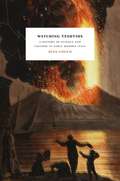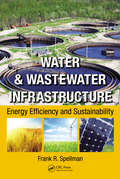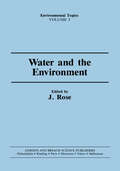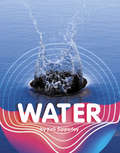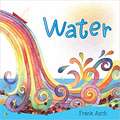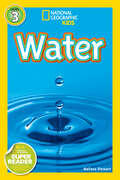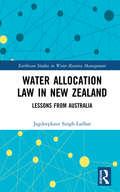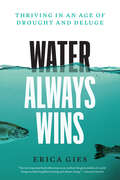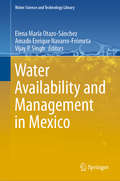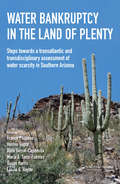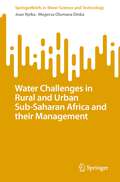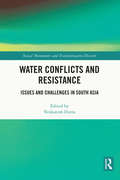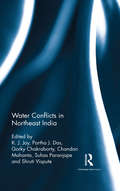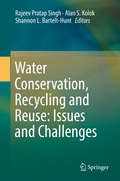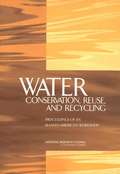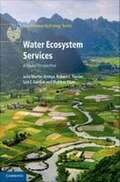- Table View
- List View
Watching Vesuvius: A History of Science and Culture in Early Modern Italy
by Sean CoccoMount Vesuvius has been famous ever since its eruption in 79 CE, when it destroyed and buried the Roman cities of Pompeii and Herculaneum. But less well-known is the role it played in the science and culture of early modern Italy, as Sean Cocco reveals in this ambitious and wide-ranging study. Humanists began to make pilgrimages to Vesuvius during the early Renaissance to experience its beauty and study its history, but a new tradition of observation emerged in 1631 with the first great eruption of the modern period. Seeking to understand the volcanoOCOs place in the larger system of nature, Neapolitans flocked to Vesuvius to examine volcanic phenomena and to collect floral and mineral specimens from the mountainside. aIn "Watching Vesuvius," Cocco argues that this investigation and engagement with Vesuvius was paramount to the development of modern volcanology. He then situates the native experience of Vesuvius in a larger intellectual, cultural, and political context and explains how later eighteenth-century representations of NaplesOCoof its climate and characterOCogrew out of this tradition of natural history. Painting a rich and detailed portrait of Vesuvius and those living in its shadow, Cocco returns the historic volcano to its place in a broader European culture of science, travel, and appreciation of the natural world.
Water & Wastewater Infrastructure: Energy Efficiency and Sustainability
by Frank R. SpellmanA critical aspect of sustainability associated with water and wastewater systems is to maintain and manage infrastructure in the most efficient and economical manner while complying with environmental regulations and keeping rates at acceptable levels. Given the high cost of fuel, our growing population, and the associated increase in energy needs,
Water & the Environment: South Florida And The Bahamas (Environmental Topics Ser. #Vol. Vi)
by RoseThis compilation of papers provides useful insights on the differing approaches to water quality and the diversity of strategies in water quality management worldwide. Considering the current situation and looking to the future, the aim of this publication is to provide a sensible addition to the literature by concentrating on several important aspects of water and the environment.
Water (A True Book)
by Christin DitchfieldDescribes the properties and uses of water, its importance to life on earth, and the water cycle.
Water (Earth Materials and Systems)
by Keli SipperleyMost of Earth is covered in water. Water falls from the sky as rain or snow. All living things need water to survive. Discover why water is an important part of nature!
Water (Fountas & Pinnell LLI Blue #Level H)
by Frank AschWater is beautiful and useful and, in its many forms, vital to life. In this lyrical companion to The Earth and I, Frank Asch encourages young readers to appreciate anew one of our most precious resources.
Water (Kaleidoscope)
by Roy A. GallantExplains why water, although common, has characteristics which make it an unusual substance.
Water (National Geographic Kids Readers)
by Melissa StewartWater is all around us; we drink it every day. In this level 3 reader, kids will learn about the water cycle, discovering how rain and snow flow into our lakes, rivers, and oceans, and later evaporate into the sky again. Vivid photography and accessible text make this book an ideal introduction to the science of water.
Water Allocation Law in New Zealand: Lessons from Australia (Earthscan Studies in Water Resource Management)
by Jagdeepkaur Singh-LadharThis book analyses water allocation law and policy in New Zealand and offers a comparative analysis with Australia. In New Zealand, it is generally accepted that water allocation law has failed to be adequately addressed and New Zealand is now faced with the problem of over-allocation in many catchments. In comparison, Australia has extensive experience in reforming its water law and policy over the last 20 years. This book provides a comparative and critical analysis of the lessons that New Zealand can learn from the Australian experience and offers guidance for the improvement of water allocation outcomes in New Zealand. Starting with the background of water allocation law and policy in New Zealand, the book traces the evolution of legal policies, including the 1967 Water and Soil Conservation Act and the 1991 Resource Management Act, and examines the role they have played in current water allocation issues. The book situates these findings within global challenges, such as the impact of climate change, and the global scarcity of and increasing demand for freshwater resources. This book will be of great interest to students and scholars researching water law and policy, natural resource management and environmental law more broadly. It will also be of use to policy makers and professionals involved in developing and implementing water allocation laws and policies.
Water Always Wins: Thriving in an Age of Drought and Deluge
by Erica GiesWinner of the Rachel Carson Award for Excellence in Environmental Journalism, Water Always Wins is a hopeful journey around the world and across time, illuminating better ways to live with water. Nearly every human endeavor on the planet was conceived and constructed with a relatively stable climate in mind. But as new climate disasters remind us every day, our world is not stable—and it is changing in ways that expose the deep dysfunction of our relationship with water. Increasingly severe and frequent floods and droughts inevitably spur calls for higher levees, bigger drains, and longer aqueducts. But as we grapple with extreme weather, a hard truth is emerging: our development, including concrete infrastructure designed to control water, is actually exacerbating our problems. Because sooner or later, water always wins. In this quietly radical book, science journalist Erica Gies introduces us to innovators in what she calls the Slow Water movement who start by asking a revolutionary question: What does water want? Using close observation, historical research, and cutting-edge science, these experts in hydrology, restoration ecology, engineering, and urban planning are already transforming our relationship with water. Modern civilizations tend to speed water away, erasing its slow phases on the land. Gies reminds us that water’s true nature is to flex with the rhythms of the earth: the slow phases absorb floods, store water for droughts, and feed natural systems. Figuring out what water wants—and accommodating its desires within our human landscapes—is now a crucial survival strategy. By putting these new approaches to the test, innovators in the Slow Water movement are reshaping the future.
Water Asset Management in Times of Climate Change and Digital Transformation (Palgrave Studies in Climate Resilient Societies)
by Robert KijakIn this book, climate change and digital transformation are explored as key strategic drivers for the contemporary practices of water utility companies. These drivers seem to be separate, but clearly, they are not.The recent weather anomalies in water stressed countries are discussed, which have been breaking records and become an elevated risk to water assets. In parallel, the book examines a contextual proposition that the concept of the fourth industrial revolution applied to the water sector, Water 4.0, assists with the water supply decentralisation and sustainability, in particular climate resilience. It further suggests that the implementation of an Asset Management System with reference to the ISO 55001 standard is a useful tool in this process.
Water Availability and Management in Mexico (Water Science and Technology Library #999)
by Vijay P. Singh Amado Enrique Navarro-Frómeta Elena María Otazo-SánchezThis book presents several complex case studies related to water management and planning in the context of pollution, growing demands, and global climate change in Mexico, but which are also relevant for other countries in Latin America. These concerns are of critical importance for policymakers who are coping with multiple conflicting interests. Water availability in Mexico is polarized, with abundant rainfall and large rivers in the south, and desert-like conditions in the north. The central region, which is the most industrialized, is overpopulated. Mexico City pours millions of cubic meters of “blackwater” into the northern valley daily and receives its clean water from the south. To address these unsustainable conditions, the world's 4th biggest water treatment plant went into operation in 2018. The water infrastructure and governance must satisfy the demands of all sectors, including agricultural, urban, and economic activities. At the same time, water resources are affected by drought, and climate change puts constraints on the supply. As such, regulation and monitoring are important when it comes to adherence to agreed plans and priorities. The book is divided into four sections. 1: Water Availability discusses quantitative aspects, such as supply, methods of calculation, and fracking. 2: Water Quality highlights pollution risks and diagnosis of water resources. 3: Water Allocation examines the sectoral demands and vulnerability due to unsustainable irrigation. 4: Water Governance and Management focuses on laws, urban rules, national parks, planning, and integrated water resources management, among other topics. The chapters include illustrative case studies in Mexico, such as basins, cities, reservoirs, and aquifers, water supply demand assessment, planning, and management.
Water Bankruptcy in the Land of Plenty (UNESCO-IHE Lecture Note Series)
by Susan Harris Franck Poupeau Hoshin Gupta Aleix Serrat-Capdevila Maria A. Sans-Fuentes László G. HaydeAs the American Southwest faces its deepest drought in history, this book explores the provocative notion of “water bankruptcy” with a view towards emphasizing the diversity and complexity of water issues in this region. It bridges between the narratives of growth and the strategies or policies adopted to pursue competing agendas and circumvent the inevitable. A window of opportunity provided by this current long-term drought may be used to induce change by dealing with threats that derive from imbalances between growth patterns and available resources, the primary cause of scarcity. A first of its kind, this book was developed through close collaboration of a broad range of natural scientists, social scientists, and resource managers from Europe and United States. It constitutes a collective elaboration of a transdisciplinary approach to unveiling the inner workings of how water was fought for, allocated and used in the American Southwest, with a focus on Arizona. Specifically, it offers an innovative scientific perspective that produces a critical diagnostic evaluation of water management, with a particular view to identifying risks for the Tucson region that is facing continuous urban sprawl and economic growth.
Water Challenges in Rural and Urban Sub-Saharan Africa and their Management (SpringerBriefs in Water Science and Technology)
by Joan Nyika Megersa Olumana DinkaSub-Saharan Africa grapples with many public health issues such as food insecurity, increased prevalence of infectious diseases, limited access to clean water supply, poor nutrition and lack of improved health services for its populace (IMF, 2021). Of all these challenges, the inaccessibility of clean water supply for both the rural and urban populace is the most pressing challenge, which has been exacerbated by extensive pollution and climate change crises. The issue of water access and supply affects both rural and urban populations. At rural areas water is accessed in yard taps and in arid regions through water kiosks managed by private owners. Among the urban poor, water access is compromised by poor supply infrastructure especially among informal settlers and risks such as contamination during the supply chain are imminent This book therefore seeks to close this knowledge gap by 1) generating a water resources inventory for Sub-Saharan Africa region, 2) exploring the water crises in both its urban and rural settings, 3) understanding the causatives of the crises and 4) suggesting viable solutions to manage the water challenges using named case studies. The aim is to improve understanding on the region’s water problems and advise scholars and policymakers on priority research areas and action plans to better water management for sustainable development.
Water Circulation in Rocks
by Paola Gattinoni Laura ScesiUnderstanding water circulation in rocks represents a very important element to solving many of the problems linked with civil, environmental and mining engineering. This book offers a synthesis of the actual knowledge about the fluid flow in rocks: - from the medium characterization and the structural geological survey to the generation of stereonets; - the evaluation of the hydrogeological parameters using either deterministic or probabilistic methodologies; - the evaluation of the preferential flow direction considering the change of the hydrogeological structures; - the methods and models used to simulate the flows. Three case studies are provided; water circulation and slope instability, hydrogeological risk linked with tunnelling, and hydrogeological risk linked with road construction.
Water City: Practical Strategies for Climate Change
by Matthew BradburyWater City offers practical solutions to some of the environmental challenges facing 21st-century cities as a result of climate change. The dense compact nature of the contemporary city makes it difficult to generate urban resilience to the effects of climate change, particularly coastal and pluvial flooding. This book describes a design-led remediation methodology that draws on catchment planning and GIS mapping and analysis to redefine the city as a series of hydrological and ecological systems. Six case studies test the presented methodology, two greenfield and four brownfield sites based in the UK, USA, New Zealand and China. Each case study is illustrated with GIS maps and perspectives. Specific solutions to the environmental problems that will be intensified by climate change are presented. Water City describes adaptation strategies to help practitioners in the urban landscape tackle these issues and make our cities better places to live. This practical guide is a key read for professionals and stakeholders in landscape architecture, urban design, planning and all those interested in how climate change will affect the future of our cities.
Water Conflicts and Resistance: Issues and Challenges in South Asia (Social Movements and Transformative Dissent)
by Venkatesh DuttaThis book presents a systematic study of transboundary, regional and local water conflicts and resistance across several river basins in South Asia. Addressing hydro-socio-economic aspects in competing water sharing and transfer agreements, as well as conflicting regimes of legal plurality, property rights and policy implementation, it discusses themes such as rights over land and natural resources; resettlement of dam-displaced people; urban–rural conflicts over water allocation; peri-urbanisation, land use conflicts and water security; tradeoffs and constraints in restoration of ecological flows in rivers; resilience against water conflicts in a river basin; and irrigation projects and sustainability of water resources. Bringing together experts, professionals, lawyers, government and the civil society, the volume analyses water conflicts at local, regional and transboundary scales; reviews current debates with case studies; and outlines emerging challenges in water policy, law, governance and institutions in South Asia. It also offers alternative tools and frameworks of water sharing mechanisms, conflict resolution, dialogue, and models of cooperation and collaboration for key stakeholders towards possible solutions for effective, equitable and strategic water management. This book will be useful to scholars and researchers of development studies, environment studies, water studies, public policy, political science, international relations, conflict resolution, political economy, economics, sociology and social anthropology, environmental law, governance and South Asian studies. It will also benefit practitioners, water policy thinktanks and associations, policymakers, diplomats and NGOs.
Water Conflicts in Northeast India
by K. J. Joy Partha J. Das Gorky Chakraborty Chandan Mahanta Suhas Paranjape Shruti VisputeNortheast India, apart from being the rainiest in India, is drained by two large river systems of the world – the Brahmaputra and the Barak (Meghna) – both transnational rivers cutting across bordering countries. The region, known for its rich water resources, has been witnessing an increasing number of conflicts related to water in recent years. This volume documents the multifaceted conflicts and contestations around water in Northeast India, analyses their causes and consequences, and includes expert recommendations. It fills a major gap in the subject by examining wide-ranging issues such as cultural and anthropological dimensions of damming rivers in the Northeast and Eastern Himalayas; seismic surveys, oil extractions, and water conflicts; discontent over water quality and drinking water; floods, river bank erosion, embankments; water policy; transboundary water conflicts; and hydropower development. It also discusses the alleged Chinese efforts to divert the Brahmaputra River. With its analytical and comprehensive coverage, 18 case studies, and suggested approaches for conflict resolution, this book will be indispensable for scholars and researchers of development studies, governance and public policy, politics and international relations, water resources, environment, geography, climate change, area studies, economics, and sociology. It will also be an important resource for policymakers, bureaucrats, development practitioners, civil society groups, the judiciary, and media.
Water Conservation, Recycling and Reuse: Issues and Challenges
by Alan S. Kolok Rajeev Pratap Singh Shannon L. Bartelt-HuntWater - a basic element of life, livelihood, food security and sustainable development - holds the key to global sustainability. The global water demand has been increased 3-fold in the past five decades and only 0.4% of the total world’s fresh water resources is available and accessible for use. The United Nations projected that half of all countries will face water scarcity by 2025 and more than one-third of the world’s population could be affected by water stress by 2050. The water problem is rapidly intensifying in the Asian region, and around 700 million people do not have access to safe drinking water. Similarly, according to the Intergovernmental Panel on Climate Change (IPCC) report, by 2050, more than one billion people in Asia alone are projected to experience negative impacts on water resources as a result of climate change. Climate change is also putting extra pressure on and adversely affecting the global water cycle, leading to irregular precipitation, more floods and droughts and creating an imbalance between water supply and demand. The availability of safe water is a major global concern due to the rapidly increasing population, urbanization, unsustainable consumption patterns, and rapid shifts in land use. It is believed that reduced access to freshwater will have cascading consequences that will pose threat to global food security, livelihood security, and cause large scale migration and economic and geopolitical tensions. As such, strategies for water conservation, wastewater reuse and recycling should be adopted in order to lessen the gap between supply and demand for water for different activities. This book provides readers with a better understanding of the water security challenges, and presents innovations to address these challenges, strengthen the science-policy interface, and develop institutional and human capacities for water security and sustainability.
Water Conservation, Reuse, And Recycling: Proceedings Of An Iranian-american Workshop
by National Research Council of the National AcademiesIn December 2002, a group of specialists on water resources from the United States and Iran met in Tunis, Tunisia, for an interacademy workshop on water resources management, conservation, and recycling. This was the fourth interacademy workshop on a variety of topics held in 2002, the first year of such workshops. Tunis was selected as the location for the workshop because the Tunisian experience in addressing water conservation issues was of interest to the participants from both the United States and Iran. This report includes the agenda for the workshop, all of the papers that were presented, and the list of site visits.
Water Cycles (DK Life Cycles)
by DKDive into the lifecycle of water and discover how it supports all life forms, how humans harness its power, and why we need to conserve it.From snowflakes falling from the clouds, deep ocean currents to hot springs, and water in space, this children&’s nature book showcases the beauty and power of water in the natural world. Inside the pages of this fascinating science book for kids, you&’ll discover: • Bite-size facts about inhabitants of freshwater and saltwater • Incredible photographs capture the power of water in nature • Great new angle about water and its many uses • Subjects included supports STEM learning • Cross-curricular science book - covering biology, the natural world, geography, global warming for kids, and much more The wonderful world of water awaits! Water is essential for life. We drink it, bathe in it, and thousands of creatures live in it. But we are running desperately low on it. Water Cycles shows children how important keeping hydrated is for our health and what we can do to save this life-giving substance in the face of climate change. This children&’s wildlife book is packed with incredible facts about water. Little ones will learn how it affects Earth&’s weather, through rainstorms, snow flurries, and cyclones, how it is used in growing food and in making electricity, as well as how water travels into our homes at the turn of a tap.From rushing rivers to vast oceans full of animals and plants, water is everywhere. Children will love seeing starfishes, manatees, and orcas come to life through spectacular photography and illustrations. It&’s the perfect gift for kids aged 7-9 years who love nature and its processes!
Water Dance
by Thomas LockerFrom a gentle mountain pond to a raging waterfall or from a silent ocean mist to a sparkling rainbow, dramatic text and paintings give water voice and substance in this tribute to water in all its glorious forms. Inspiring and informative, Water Dance is a poetic introduction to one of nature’s most basic elements. Scientific facts about water and its role in our lives are included. “Thirteen lushly romantic oil paintings, accompanied by spare, poetic text, offer viewers a sensuous introduction to the water cycle.”--The Bulletin
Water Distribution System Operation and Maintenance, 6th Edition
by Office of Water Programs Kenneth D. KerriThis textbook is designed to train operators to safely and effectively operate and maintain water distribution systems.
Water Drops: Celebrating the Wonder of Water (Excelsior Editions)
by Peter E. BlackIn this engaging book, hydrologist Peter E. Black celebrates the wonder of our planet's most precious natural resource. In these brief, nontechnical essays, readers are introduced to water's unique scientific properties, the vital role it plays in Earth's ecology and ecosystems, and the impact it has had on human history, culture, art, law, and economics. At turns educational and inspirational, humorous and reverent, the book also sounds a cautionary note: water is abundant, but it is also scarce. Only three percent of the earth's water is fresh, and only a small percentage of that fresh water is available for human use and consumption. Therefore, it must be managed carefully, and understood, lest we find ourselves with too little, too late.
Water Ecosystem Services: A Global Perspective (International Hydrology Series)
by Iain J. Gordon Julia Martin-Ortega Robert C. Ferrier Shahbaz KhanThis comprehensive volume describes how ecosystem services-based approaches can assist in addressing major global and regional water challenges, such as climate change, biodiversity loss, and water security in the developing world, by integrating scientific knowledge from different disciplines, such as hydrological modelling, environmental economics, psychology and international law. Empirical assessments at the national, catchment and regional levels are used to critically appraise this systemic approach, and the merits and potential limitations are presented. The practicalities of this approach with regard to water resources management, nature conservation, and sustainable business practices are discussed, and the role of society in underpinning the concept of ecosystem services is explored. Presenting new insights and perspectives on how to shape future strategies, this contributory volume is a valuable reference for researchers, academics, students and policy makers, in environmental studies, hydrology, water resource management, ecology, environmental law, policy and economics, and conservation biology. Provides a practical definition of ecosystem services-based approaches for both researchers and practitioners. Provides a definitive reference for future research and the implementation of ecosystem services-based approaches within the water sector and beyond. Discusses new and unexplored dimensions to the ecosystem services field, such as human rights, thereby enhancing the concept for both research and practice. Brings together knowledge across a range of disciplines and is suitable for a broad audience.
